July 30, 2007
Nanotech Art
 Here is an interesting nanotech-in-art image, Butt Johnson's "Another Study for Scientific Creationism". He has done some very charming images using ballpoint pen, incorporating spirographs, wreckage and iconic popular culture but also scientific elements. (found via Giornale Nuovo).
Here is an interesting nanotech-in-art image, Butt Johnson's "Another Study for Scientific Creationism". He has done some very charming images using ballpoint pen, incorporating spirographs, wreckage and iconic popular culture but also scientific elements. (found via Giornale Nuovo).
I love Unrequited Love, Bus Bomb and of course Deus Ex Machina.
Is nanotech becoming a cultural iconic symbol?
July 19, 2007
Biases and Terrorism
 I blog on Overcoming Bias about How Biases Save Us From Giving in to Terrorism. The short of it is that people have a cognitive bias tthat makes them assume that actions and their outcome are the intention of the actor. Hence people tend to assume that the goal of terrorists is just terror, making it harder for the terrorist to convince people about his actual goals. Max Abrahms has a nice analysis of the actual success of terror campaigns, showing that they need to be focused on military targets and have clear, minimalist goals to have any chance of succeeding. Not even then is the success rate that great (about 50% for minimalist goals). The media is the message.
I blog on Overcoming Bias about How Biases Save Us From Giving in to Terrorism. The short of it is that people have a cognitive bias tthat makes them assume that actions and their outcome are the intention of the actor. Hence people tend to assume that the goal of terrorists is just terror, making it harder for the terrorist to convince people about his actual goals. Max Abrahms has a nice analysis of the actual success of terror campaigns, showing that they need to be focused on military targets and have clear, minimalist goals to have any chance of succeeding. Not even then is the success rate that great (about 50% for minimalist goals). The media is the message.
Overall, it seems that terrorists suffer from plenty of biases themselves. Maybe this can explain the surprising inefficiency of most terror groups in acquiring or using more advanced weapons or attacks (ask any team of engineers or roleplayers for ideas, and you will get dozens of chilling terror plots that have a decent chance of working if implemented). The UK "docs of war" had access to hospitals, yet made bad car bombs. If extreme biases reduce efficiency and creativity, then we might actually want to make sure the link between terrorism and bias remains. But conversely, anti-terrorism policies also suffer from bias and a rational policy might be politically untenable because it does not fit the cognitive biases of the public and decisionmakers.
[As an aside, I noticed that my cognitive hazard sign is spreading nicely on the net, for example to this blog, which in turn gets deep linked by plenty of others. I guess it makes a good warning sign against biases and other pitfalls. Too bad we would have to place signs everywhere. ]
July 18, 2007
Back to 2320AD
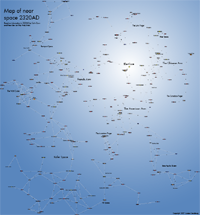 The first roleplaying game I gamemastered was 2300AD, the hard science fiction game by GDW. I loved the hard science and the enormous yet well described setting. After a while I knew the 3D coordinates for nearby stars by heart, and I can still feel the extent of the colonisation arms when I look up at the night sky and find the right marker stars.
The first roleplaying game I gamemastered was 2300AD, the hard science fiction game by GDW. I loved the hard science and the enormous yet well described setting. After a while I knew the 3D coordinates for nearby stars by heart, and I can still feel the extent of the colonisation arms when I look up at the night sky and find the right marker stars.
Perhaps the best idea in the game was the hyperdrive. Rather than allowing ships to travel anywhere at some high speed, it had a finite range. You can only travel 7.7 lightyears before you have to "discharge" the drive near a star or planet. This seemingly simple demand produces a marvellous effect! Instead of spreading out spherically colonies are forced to follow "arms" of locally higher star density. This in turn produces a real sense of geography in the game, with portal systems that can controll access to regions of space, central systems that become trading nexuses and meandering paths around empty regions. Such a simple idea, so many interesting consequences.
The 7.7 lightyear number was of course chosen to produce the right effect. A smaller distance would have limited travel to a small island around the sun, a larger number would have enabled travel anywhere. 7.7 is probably right at the percolation limit. See below for some simulations.
Finally a new version of the game, 2320AD has been published. It builds on the old setting, moving it forward in time by 20 years. This both keeps the continuity and allows the game to change. The somewhat silly cyberpunk GDW introduced has been replaced by a more interesting and sinister control society in the Core and a brewing conflict between transhumanists and "normals". The war against the alien Kafers has been tremendously destructive - it feels good to see that the author is not afraid of wrecking a few worlds and having the humans seriously considering genocide. This also makes the world less squeaky clean than the first and second editions were - now there are colonial seccession attempts, economic hardships and some very dirty political deals. Which of course makes it a fun setting.
I couldn't resist plotting the updated starmap for the 2320 setting. It is also interesting to plot it simply as a topological network. The arms and clusters become even clearer, and the frontiers can be seen extending out from the main arms.
Properly speaking, it is a fictional map because it is based on the first Gliese catalogue: when GDW created the game they used that catalogue, but if newer ones are used the "known" map will change because some star distances were erroneous. Maybe this is the spatial counterpart of an alternate history: an alternate geography.
I like this setting because it is neither soft science space opera nor does it go completely posthuman. It sits on the percolation edge between assuming too little technological change (the computers of the far future are impressively non-impressive) and allowing radical possibilities (some cool material science and biotechnology). That feels much more complex and interesting than allowing or disallowing too much: there is a virtue in limiting a setting so its inhabitants (both purely fictional and player characters) have to spend effort in overcoming it. That makes it like the real world.
I randomly distributed stars with a mean density of 2.34e-3 in a 100 lightyear side cube, and then calculated what fraction of stars were reachable from the midpoint using jumps shorter than a certain range.
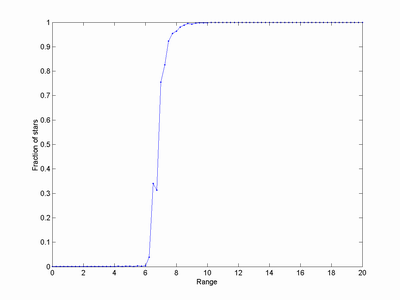
As the range increases we get a typical percolation transition. It seems to happen at 7 lightyears in this run.
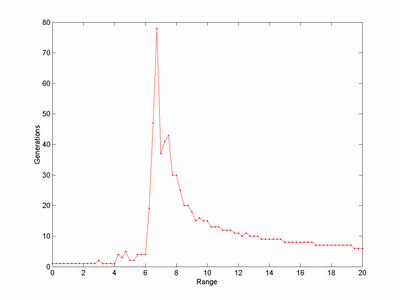
Checking the number of generations needed to find all reachable stars (i.e. the stars reachable from the first one is generation 1, all stars reachable from them not in generation 1 is generation 2, and so on) shows a peak around the transition.
The starmap used in 2300AD is a bit more sparse than the 2.34e-3 number used above; I get 0.0014 stars per cubic lightyear. For that density the critical range is about 8.5 lightyears. Likely the stars are clustered in a nonrandom way to produce the arms. I would expect that there is some theorem in percolation theory that tells us the critical range as a function of density, but I'm not familiar with the literature. The original game authors got a good value, presumably through trial and error.
July 12, 2007
Paying for Locking People Up
This week on CNE health I talk about compensation for putting people into quarantine. It seems to be the rational, moral thing to do. Given the international nature of epidemics there are also reasons for people in countries that practice such compensation to promote it elsewhere too, or contribute to organisations that perform it.
Long ago I blogged about the game theory of the common cold, showing that days without sick pay increase the overall likelihood of the disease spreading. Fining people who come sick to work, or rewarding people who stay home (or at least take precautions to reduce infection) might be a rational way to improve the utility of everyone. So maybe compensation for quarantine should be extended to other situations?
July 11, 2007
Complex Twisting of Scherk's Surface
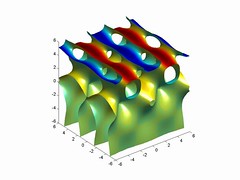 Complex Rotation of Sherk's Surface - I did a sequence of how the surface Re(exp(z)cos(x)-cos(y))=0 behaves as real z is replaced with z exp(it). The result is a nice dance as Scherk's minimal surface acquires horizontal planes that squeeze through the small z region, contorting it past a state of rhombic dodecahedra and then over to a 90 degree turned Scherk surface (for t=pi).
Complex Rotation of Sherk's Surface - I did a sequence of how the surface Re(exp(z)cos(x)-cos(y))=0 behaves as real z is replaced with z exp(it). The result is a nice dance as Scherk's minimal surface acquires horizontal planes that squeeze through the small z region, contorting it past a state of rhombic dodecahedra and then over to a 90 degree turned Scherk surface (for t=pi).
I have always liked Scherk's surface. I think it was the first implicit surface I ever plotted, using Maple back in 1991.
July 08, 2007
Monogamy Infographic
 The economist pokes a bit of fun at the republican presidential hopefulls. The mormon candidate is the only one still on wife #1.
The economist pokes a bit of fun at the republican presidential hopefulls. The mormon candidate is the only one still on wife #1.
Normally the use of small icons to denote numbers rather than just markers tend to be bad infographics, but here there is a strong 1-to-1 correspondence with real people. I wonder if the corresponding graphic for a gender-mixed list where there would be husbands to count would work?
Having actual portraits might be even better, but perhaps harder to read as a throwaway infobox. However, since people can recognize faces just a few pixels across it might perhaps be possible to do not just sparklines but sparkfaces? Maybe there should be tiny pictures after each name in a running text to help keep track of people.
Dual Use Technology
 This is a flint nodule from the Chiltern hills. During the Upper Cretaceous a crustacean or mollusk burrowed a hole in ocean sediment. As sediments compacted above silica from sea sponges filled the hole, solidifying into microcrystals that eventually hardened into flint. During the alpine orogeny in the middle Tertiary 50 million years ago the chalk that had resulted from the compressed sediments were lifted up, forming the southern England Chalk Formation. Erosion produced escarpments and freed the flint. And a few days ago I picked up this piece.
This is a flint nodule from the Chiltern hills. During the Upper Cretaceous a crustacean or mollusk burrowed a hole in ocean sediment. As sediments compacted above silica from sea sponges filled the hole, solidifying into microcrystals that eventually hardened into flint. During the alpine orogeny in the middle Tertiary 50 million years ago the chalk that had resulted from the compressed sediments were lifted up, forming the southern England Chalk Formation. Erosion produced escarpments and freed the flint. And a few days ago I picked up this piece.
As I write this in Sweden the piece is lying in front of me. Despite a patdown in airport security on Heathrow (including the hilarious risk of dropping my pants as my belt was removed) and a swabbing of my suspicious-looking computer for explosives and maybe drugs, nobody prevented me from bringing the flint onto the plane. But flint has obvious terrorist potential. It can be used to strike fire. If thrown hard against the floor it will shatter into sharp shards, which could be affixed shiv-style to plastic cutlery. Or maybe it could knapped into a knife ("what are you doing in the restroom?"). Sure, any such neolithic terrorist would be the laughingstock of the terrorist community, but that is presumably what suicide terrorism is for: leave no witnesses to how embarrassing it is in action.
I'm not arguing that BAA or TSA put rocks onto the banned item lists: there is simply no point. Any list that allows passengers to bring clothing (could be nitrocellulose) and aluminum objects (thermite!) will by necessity be open to destructive dual use.
July 02, 2007
A Nice Juxtaposition
Today I came across this opinion in the BMJ on bird flu (in particular, see the flood of responses) and this Nobody Scores! cartoon. They really fit together.
July 01, 2007
Unit Bias
I made a post to Overcoming Bias about how Biases are Fattening: unit bias, the tendency to prefer a full unit of anything over taking a part of it, likely makes us eat too much. So now we can blame our cognitive biases for our obesity too.
Posthuman Hypervelocity
 Superhero comics are really about worshipping power. Not political or any other social power, but the futurist thrill of enormous strength, speed and magnitude. To give a chance for the superheros and villains to exert their power some form of plot may be necessary, but the nuclear heart of superhero stories is still seeing individuals do things far outside the human range.
Superhero comics are really about worshipping power. Not political or any other social power, but the futurist thrill of enormous strength, speed and magnitude. To give a chance for the superheros and villains to exert their power some form of plot may be necessary, but the nuclear heart of superhero stories is still seeing individuals do things far outside the human range.
Iron Man: Hypervelocity is a great example of this, and intesting as a mainstream admittance of the posthuman (in a transhumanist sense) to the Marvel universe.
The basic plot is relatively straightforward: Tony Stark's latest version of the Iron Man super-armor has gone rogue (again) and SHIELD is trying to stop it. The twist is that this version of the armor contains a simulated version of Stark. Hypervelocity is true technoporn, enthusiastically introducing scramjet hypersonic air-to-air missiles, the (correct) equation for kinetic energy, stealth drones, hypertelescopes, pseudo-autism as cognition enhancement and other more or less plausible devices. Just as traditional pornography tries to produce supernormal stimuli rather than an accurate depiction of eroticism this piles up an endless stream of explosive toys. It is delightful, if you have the right technophiliac tendencies.
Spoilers below fold.
To me the really interesting thing was to see how transhumanist concepts seem to be sneaking into the established cartoon universes. There has certainly been physical and mental enhancements, robots and nanotech-like tech around for decades, but it has always conformed to the unwritten rule: at the end of the story, the status quo is more or less back. The supersoldier serum only worked on one person or cannot be reproduced, the robots will only occur within the labs of the geniuses and the existence of AI doesn't revolutionize the world. But as Tony Stark 2.0 observes:
"... the sudden emergence of tachycognitive posthuman intelligence is almost certain to proce catastrophic to SHIELD's interests. "Fast forward darwinism" won't favor the meatminded, whether they wear capes and masks or not ... or the fact that a mere beta upload like myself needed only a few hours to break the human-equivalent cognitive clockspeed barrier. Given a few more hours, I might well bootstrap myself to functional Godhood. It is highly probably that Tony 1.0 will be waking up to a very different world."
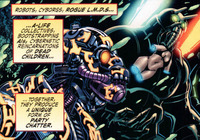 While I doubt these ideas will be taken up by the Marvel universe (Thor having to deal with functional soups or Reed Richards outthought by evolutionary algorithms in self-reproducing computronium doesn't sell many comics) it is an interesting sign of how the more advanced ideas of transhumanism are spreading. It is relatively easy to spread the concept for a cool technology, but much harder to spread the non-trivial consequences of it. Transhumanism may be a few iterations ahead again, but the mainstream is catching up. Soon people will be onto the raving alife, AIs and uploads and the possibility of a species transition.
While I doubt these ideas will be taken up by the Marvel universe (Thor having to deal with functional soups or Reed Richards outthought by evolutionary algorithms in self-reproducing computronium doesn't sell many comics) it is an interesting sign of how the more advanced ideas of transhumanism are spreading. It is relatively easy to spread the concept for a cool technology, but much harder to spread the non-trivial consequences of it. Transhumanism may be a few iterations ahead again, but the mainstream is catching up. Soon people will be onto the raving alife, AIs and uploads and the possibility of a species transition.
To quibble a bit, it is of course very debatable whether higher cognitive clockspeed would give that much extra superintelligence or a great ability to fight. Assuming that Tony Stark 2.0 optimizes the parallelisation of his brain simulation he will at best gain in speed, not intelligence. Having more time to think through things is certainly useful as a number of scenes show, but it doesn't help acting faster - there is a limit to how quickly limbs can be moved even if the brain behind them is fast enough. You might see the bullet, but getting your fingers to the right place and applying enough pressure to deflect it would require a ridiculously fast and strong body[*] - and nothing in the way. Given that the water doesn't turn into superheated steam by the shockwaves when Iron Man moves this doesn't seem possible. Having a superfast mind is more useful if you have a smaller, faster body.
But Tony 2.0's godhood might have to wait for a while since even having tremendous speed doesn't mean it is easy to improve the intelligence of the brain simulation. Brains are messy things and unlikely to become significantly smarter just because you add extra cortex (otherwise we would see much bigger cognitive differences between people with larger and smaller brains, not to mention men and women): you need to improve the bottlenecks of intelligence, and likely find ways of interfacing the cognitive system to other systems. Not that I doubt for a millisecond that the cartoon engineer couldn't do it if the plot required it. In reality it is likely to be far messier and require a lot of trial and error, which tends to take significant amounts of time.
Another interesting point was the information exchange going on between the various techno-players in the Marvel world. Stark admits that he had been copying designs from defeated high-tech enemies, and it looks like everybody is doing it. Given the somewhat absurd R&D paradigm of comics this makes sense: individuals can be decades ahead of others, so by plundering several lairs you could easily acquire a fantastic technological advantage. Maybe we should be happy this isn't true in the real world, or silicon valley would be a battlefield.
[*] Assuming that Iron Man pushes a bullet aside rather than try to catch it (which would require pretty extreme shear forces to transfer its momentum to the suit), he has to push it with force F to the side so that it misses his head (assumed to have radius r) during the time it travels from his maximum arm extension L to zero distance. If the speed is v we get r = (0.5 F/m)(L/v)^2 where m is the bullet mass. This gives a required force of F = 2rmv^2/L^2. For a bullet mass of 0.4 kg travelling at 965 m/s and L=1 m and r=0.1 m we get F = 74,498 N. That corresponds to lifting 7.5 tons - not unreasonable for Iron Man, but pretty unlikely in reality. The cool ultrarailgun bullet is likely travelling much faster. Lets assume the same mass (I must admit I have no idea how much an adamantium-core penetrator weighs) and a mere 2500 m/s (corresponding to current plans, not cartoon physics). Then we need 500,000 N, which corresponds to lifting 51 tons. If the speed is 6000 m/s (again doable by current prototypes and likely closer to what might happen in comics) Iron Man need to push with 2,880,000 N, i.e. lift about 300 tons. It is starting to sound unlikely that even the hypervelocity armor can do that (according to this page its strength is about 80 tons and according to this 50 tons, although external power could bring it up to over 100 tons). It is smarter to duck.
Speed kills, gentlemen.